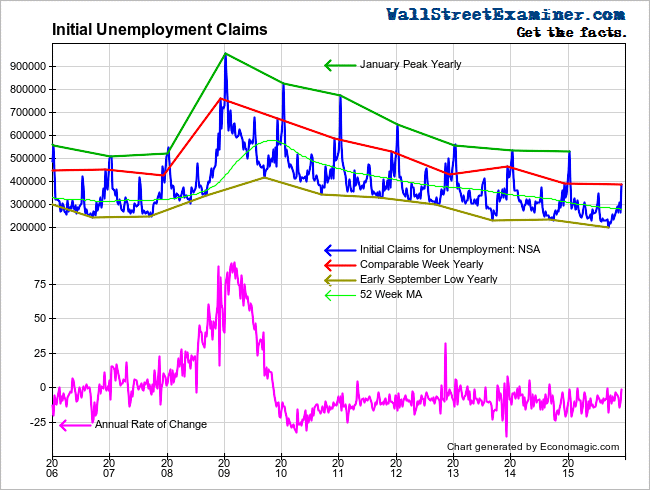First time claims for unemployment compensation continued their string of record lows for the same week of the year but the improvement in the weekly number slowed radically last week in what could be the first sign of trend change.
The actual number, not subject to any seasonal hocus pocus was 384,481. That was 2,668 claims per million employed workers. That compares with bubble low of 3,350 per million for the same week of December, in 2007 just after stocks had topped out and the housing bubble was deflating. At the top of the internet/tech bubble in December 1999, the number was 2,877. The current bubble continues to break the records of the past 43 years.
The Department of Labor (DoL) reports the unmanipulated numbers that state unemployment offices actually count and report each week. This week it said, “The advance number of actual initial claims under state programs, unadjusted, totaled 384,481 in the week ending December 5, an increase of 121,853 (or 46.4 percent) from the previous week. The seasonal factors had expected an increase of 103,867 (or 39.5 percent) from the previous week. There were 389,284 initial claims in the comparable week in 2014. ”

We use actual data, as opposed to the seasonally manipulated headline numbers which Big Media shovels out for mass consumption. To see from the actual numbers if there's any evidence of trend change we must look at how the current week compares with the comparable week in prior years.
The actual change for the current week versus the prior week was an increase of +121,853. The 10 year average for actual data for that week was an increase of +138,040, so the current week was a little better than average. However, the same week last year saw a jump of only +94,895. The current week was not as strong as this week last year which could be a sign that the momentum is beginning to shift.
Week to week changes are noisy. The trend is what matters. Since 2010 the annual change rate each week has mostly fluctuated between -5% and -15%. Last week was outside that range with a year to year drop of just -1.2%, another sign of possibly slowing momentum. But one week does not a trend make. The two weeks prior were within the usual range. Still, this bears watching.



